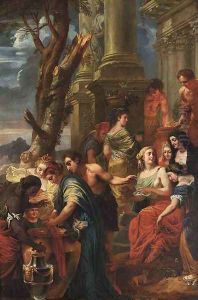Jan-Erasmus Quellinus Paintings
Jan-Erasmus Quellinus was a Flemish Baroque painter, born on November 17, 1634, in Antwerp, Belgium. He stemmed from a prominent artistic family; his father, Erasmus Quellinus II, was a well-known painter, and his uncle, Artus Quellinus the Elder, was a famous sculptor. Having been raised in an environment surrounded by art and culture, Quellinus was primed to follow in his family's footsteps.
He began his artistic training under the guidance of his father and later completed his studies with the celebrated Peter Paul Rubens, which had a profound influence on his style and technique. Quellinus's work is characterized by a blend of his father's more classical approach with Rubens's dynamic baroque sensibility. After Rubens's death in 1640, Quellinus continued to work in Antwerp and became a master in the Guild of Saint Luke by 1651.
Quellinus's oeuvre includes a variety of works, such as historical paintings, portraits, and religious subjects. One of his notable contributions was to the decoration of the Huis ten Bosch in The Hague, where he collaborated with other artists in the Oranjezaal project, a significant undertaking initiated by Amalia van Solms to commemorate her late husband, Prince Frederik Hendrik.
Throughout his career, Quellinus enjoyed considerable success and worked for various prestigious patrons, including the Habsburg rulers for whom he produced several works. His art was appreciated for its erudition, refined execution, and often allegorical depth. Quellinus not only worked in Belgium but also traveled and worked in other parts of Europe, such as Italy, where he was influenced by the Italian masters.
Jan-Erasmus Quellinus married Cornelia Schut on 23 August 1663, with whom he had 11 children. The Quellinus family, with its strong artistic lineage, continued to have a lasting impact on Flemish art. Jan-Erasmus Quellinus passed away on March 11, 1715, in Mechelen, Belgium. His legacy is preserved in various European art collections, and his works continue to be studied for their contribution to the Flemish Baroque movement.



